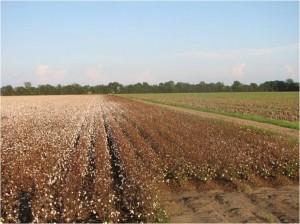Yes, I would expect tarnished plant bug activity in cotton to pick up over the next several weeks. Plant bug infestations have been average at best in most locations over the previous two weeks. However, we’ve observed many plant bugs in blooming soybeans and tasseling corn. Tarnished plant bugs are not a threat to these crops, but these crops do influence populations in cotton. I say let them stay in corn or soybean, but unfortunately they will eventually leave.
The Corn Effect. There is a conception that plant bugs move out of corn in big numbers into adjacent cotton, but that is only partially true. The reality is more complicated, and there are several reasons why having a lot of corn in an area tends to increase plant bug populations in cotton.
- Corn is not much of a host for plant bugs for most of the season, so having a lot of corn acres will concentrate plant bugs into what is left (including cotton). This is probably the primary reason why plant bugs infestations in cotton tend to get worse as corn acres increase. The higher the corn acres, the more likely it is that plant bugs will concentrate in cotton.
- There is a window beginning at tasseling and continuing for 2-3 weeks when plant bugs will reproduce in corn. Adult tarnished plant bug feed in corn tassels during pollination (for the first week or so). They will also lay eggs in corn during this time frame. The adults may then leave the field, but there will be a new generation of adults migrating from corn 2-3 weeks after pollination is complete. At this time, corn is producing new adults that can infest cotton. Corn is not a reproductive host for adults prior to tasseling and after brown silks are present.
-
An edge effect is sometimes seen where tarnished plant bug infestations and injury is worst on corn/cotton interfaces (pictured right). Again, this effect tends to be more intense where there is a lot of corn and especially in more delta-like environments where there are fewer tree lines and other non-crop borders. During much of the season, I believe corn acts as a wall for plant bugs, essentially causing populations to stack up in the adjacent cotton. During the time when new plant bug adults are leaving corn, they may initially be more concentrated along these edges … and then you get the double whammy of the same corn field now acting as non-host barrier.
Do’s and Dont’s
- Do NOT spray corn for plant bugs. Much of the “corn effect” is not just plant bugs originating from corn. Spraying a pyrethroid will not be particularly effective and just makes plant bugs harder to kill in cotton later. There are few insecticide options for plant bugs in corn. Besides, it just seems fundamentally wrong to treat a crop where they do not cause economic damage before we know how intense problems will be in cotton. Remember, corn is just one of many hosts for the tarnished plant bug. The numbers of tarnished plant bugs found in corn varies considerably and is sometimes very low.
- In addition to scout and spray treatments, consider making additional perimeter treatment(s) of cotton fields adjacent to corn. This would be a good potential use of Diamond, and I would suggest a rate of 6 oz per acre. The intense edge effect that is sometimes observed is typically concentrated within a boom width of the border.
- In areas with a history of high plant bug infestations, or for fields surrounded closely by a sea of corn, consider using Diamond early in the rotation. I would not use Diamond until a field was at least at the third week of squaring. Remember that Diamond does not kill adults.
- It’s too late for this year, but try to keep corn and cotton acres as separate as possible. Avoid planting cotton where it will be surrounded by corn.
- Do NOT assume we are going to have widespread, blow out populations of plant bugs. This is not a certainty in most of Tennessee. This is what separates us from the much of the central and southern Mississippi River Delta where they routinely spray 5-10 times per year just for tarnished plant bugs.


